
Visit Shrines
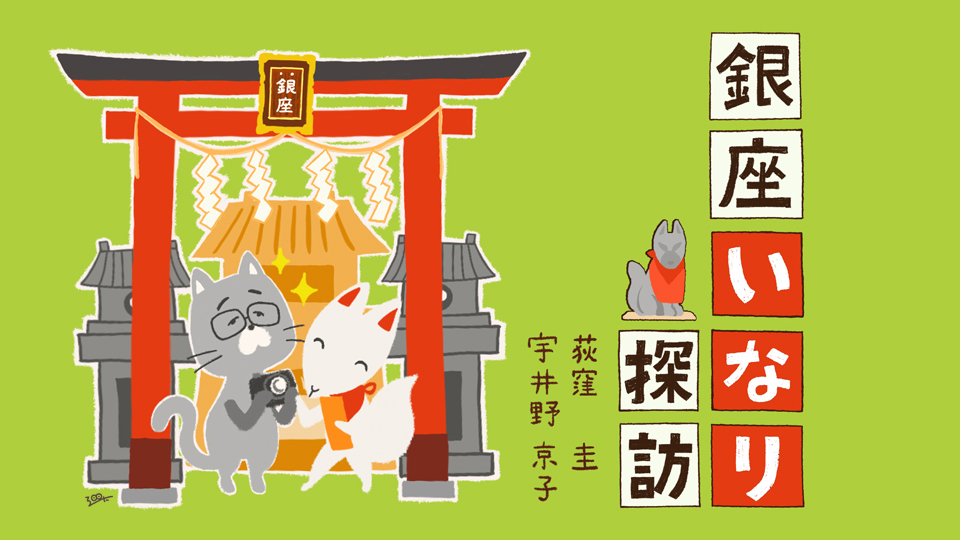
Visiting Ginza’s Shrines Vol. 8 Kumagai Inari Shrine
2021.11.01
It is up to the individual which path they will take. However, a path may change depending on the people one meets. This may be similar to how the evolution of a town depends on who lives there.
This time we will cover the story of an Inari Shrine that has survived until present times through its ties with different people.

- Uino
- Have you ever experienced having your course of life determined by an encounter with a particular person?
- Ogikubo
- That is one difficult question to answer coming out of the blue. The way I have lived my life, many people invite me to try different things, and if something seems interesting, I try it. Does the average person find his future defined by a particular overwhelming encounter?
- Uino
- I was just thinking about how people often talk about how they would not be here today if it were not for so and so when they receive awards.
- Ogikubo
- I see. We do hear that story quite often. But why start with such a random question?
- Uino
- Well, that is exactly how the story of Kumagai Inari Shrine goes. It would not be here today if it were not for the people it has come in contact with.
- Ogikubo
- In which area of Ginza is it located?
- Uino
- We are in Ginza 7-chome. To get to the shrine, we will walk towards Tsukiji on Hanatsubaki-dori from the Ginza 7-chome intersection.
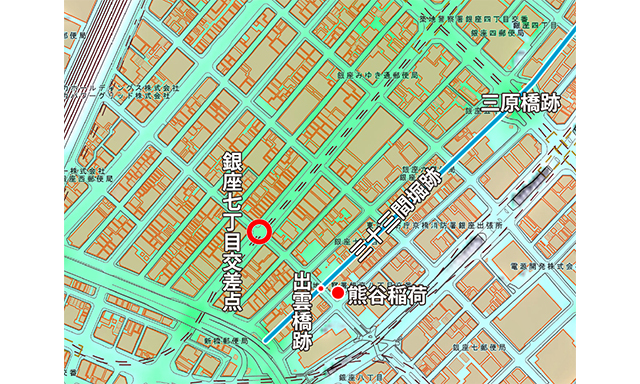
The area around Chuo-dori was land from old times, and is thus slightly higher than surrounding areas.
- Ogikubo
- If we walk on, we will arrive at the ruins of Sanjusangenbori River.
- Uino
- Izumobashi Bridge used to hang over the river, and the shrine was located right near the bridge
- Ogikubo
- Now I see it. A small shrine in the corner of a building just beyond Sanjusangenbori.
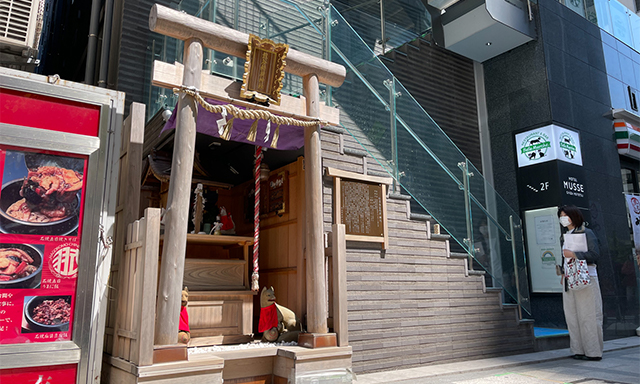
- Uino
- This is Kumagai Inari Shrine.
- Ogikubo
- So it has survived the times in the corner of a building. Why is it called Kumagai Inari?
- Uino
- Since it is a local Inari shrine, it does not have firm historical records. However, the story goes that when Kumagai Naozane, a successful warrior in the Battle of Ichi-no-tani in the Genpei War, dropped by this area during his triumphant return to Kumagaya, he bestowed a talisman for defense in response to the strong request of the local people.
- Ogikubo
- Kumagai Naozane is a famous warrior. The way it enshrines the Hachiman god, the tutelary deity of the Genji clan, while it is an Inari Shrine, gives reality to its warrior roots.
- Uino
- Then, that must mean that this area has been here for a long time.
- Ogikubo
- The Tokaido road came through Ginza in the Edo period, and before then, it was a piece of peninsula-like land extending out southwards called Edomaeshima. You can see that even today, the elevation is still slightly varied in different parts of Ginza. The Inari Shrine was located on the southeastern edge of Edomaeshima. The main road (Kamakura-kaido) did not run through Edomashima back in the times of the Genpei War, so they must have come by boat. Perhaps they took a boat from Kamakura and stopped by one of the fishing villages in this area, and then headed northwards to Kumagaya through Arakawa.
- Uino
- Wow. Is that true?
- Ogikubo
- That was just based on my imagination. It happened 800 years ago – I have no way to know. I am more interested in why Kumagai Naozane decided to come out here.
- Uino
- Kumagai Naozane’s story was a popular theme for plays during the Edo period, wasn’t it?
- Ogikubo
- You could be right. It might have something to do with the fact that this area was the theater district during the Edo period. Let me take out a local map from back when Sanjusangenbori still existed. I have a map of Kyobashi-ku in 1941 (Showa 16) with me. Let’s see if we can find Kumagai Inari Shrine…
- Uino
- Wow. I always wonder why you have so many old maps in your possession.
- Ogikubo
- It is my hobby to collect old maps of Tokyo. See, Izumobashi Bridge is located southeast of the Ginza 7-chome intersection and there is a shrine across the bridge. Although the area is a part Ginza now, it had always been called Kobikicho since the Edo period. Hence, the shrine was a tutelary deity of Kobikicho.
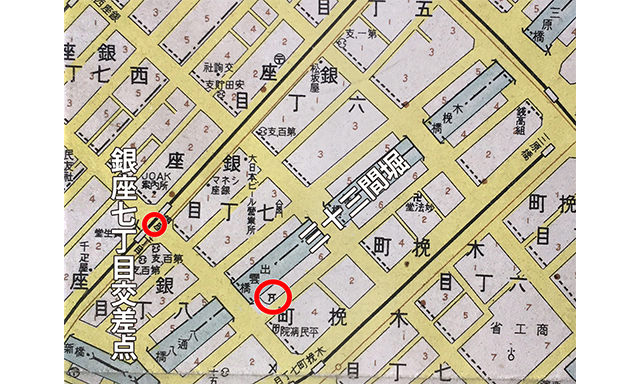
The area beyond Sanjusangenbori was not yet a part of Ginza, and was called Kobikicho.
The symbol of a shrine is marked where Kumagai Inari Shrine used to sit.
- Uino
- I see. The shrine used to sit in this location. Why was the area called Kobikicho?
- Ogikubo
- When they built Edo Palace, the “kobiki” artisans were gathered in this area. “Kobiki” artisans are the craftsmen who sawed logs into lumber and boards. The logs were transported by boat, so this area along the Sanjusangenbori was ideal. It was later on that it became a theater district.
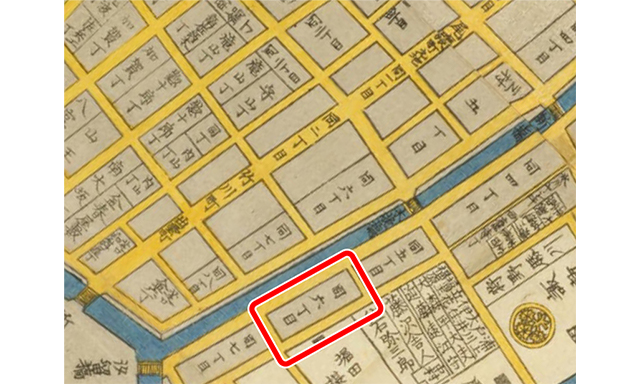
The area outlined in red is Kobikicho 6-chome, where Kumagai Inari Shrine stood.
- Uino
- The Inari Shrine later survived warfare. It miraculously remained standing in the ashes when all the other buildings surrounding it had been burnt down. On the other hand, Sanjusangenbori was buried and disappeared from local maps for a while.
- Ogikubo
- Perhaps because it was not lost in the fires, the shrine can still be found on maps made after the river was buried.
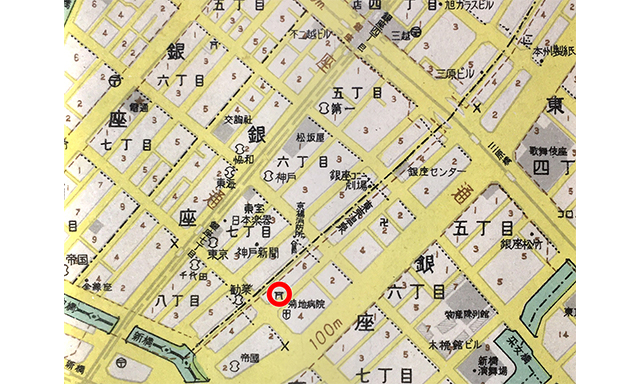
Although Sanjusangenbori was buried, the shrine still remains.
- Ogikubo
- But I guess even an Inari Shrine with such a history eventually became lost as Kobikicho became a part of Ginza and building after building was built across the area from Ginza to Higashi Ginza.
- Uino
- Yes, that is right. Actually, the shrine was moved to its current location only recently in 2018.
- Ogikubo
- I’m very interested to know how the Inari Shrine in Ginza was protected and restored.
- Uino
- Close to the Inari Shrine in Kobikicho lived Takemoto Kintaro, leader of the fire-fighting team of “Mo-gumi,” the local reciprocal support group, and a locally famous chanter of the fire-fighting song. Takemoto-san had looked after the shrine from before World War II. There could be no better team than a fire-fighting team to protect a shrine enshrining a deity of fire-prevention. I have heard of a saga that the team discovered from among heaps of documents, records of the shrine being solicitated from Fushimi Inari Shrine, the headquarter of Inari Shrines
- Ogikubo
- It would be difficult to find any district today with such solidarity.
- Uino
- That is true. It is unfortunate that culture based on strong human ties are disappearing. The land in this area was sold to the private sector after Sanjusangenbori was buried. Landowners changed from time to time, and smaller pieces of land were eventually consolidated to for large construction projects.
- Ogikubo
- So people became dispersed, and the land was consolidated. And in that process, the shrine was moved around.
- Uino
- Yes. It was sometimes located in a narrow space between buildings and other times, in a narrow backstreet. It changed its location several times within the same block. As it became hard to find, less people knew about it, and it eventually disappeared from local maps. It took thirty years to put together one large piece of land to construct one large building – HOTEL MUSSE. There were discussions over many different ideas of where to place the shrine – whether to move it to the rooftop, or to the entrance of the hotel, close to where it originally stood. However, it was concluded that a shrine should be facing the main street to allow many people to stop by for worship. This is how they decided to build it on Hanatsubaki-dori.
- Ogikubo
- That is why it stands where Sanjusangenbori used to run.
- Uino
- What’s more, the shrine has modern features that you would only find in a town like Ginza with tall buildings. The shrine pavilion and torii gate can be moved.
- Ogikubo
- What for?
- Uino
- The power switchboard of the building is right behind the shrine so it had to be movable in case someone had to open the switchboard.
- Ogikubo
- How clever. Now that you have mentioned it, it actually does look movable.
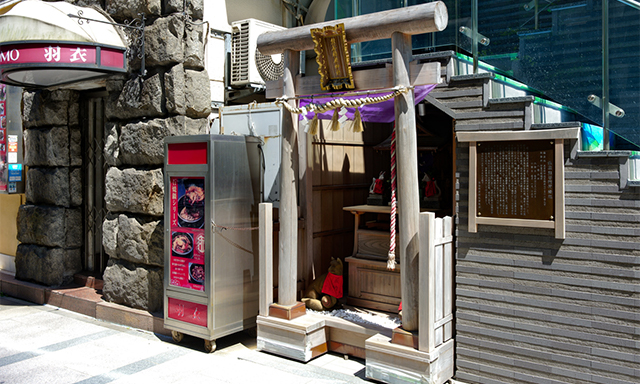
- Uino
- Although it has moved around and changed its appearance, Kumagai Inari Shrine has continued to be supported by the people of the times. Today, it even participates in the Visiting Ginza Hatcho Shrines pilgrimage.
- Ogikubo
- Starting as a tutelary deity of Kobikicho, where sawmill workers were gathered in the Edo period, it was later looked after by Takemoto-san, leader of the local fire-fighting team, followed by the current owner who has care for it through the building boom during the high-growth period and bubble economy up until now. Finally, in Reiwa, t has been restored on the main street.
- Uino
- Yes. Kumagai Inari Shrine has continued to be the local tutelary deity, changing its appearance under the care of different people. Perhaps it carefully chose the people who it would be involved with. Encounters with the shrine may have changed people’s lives too. The story sounds different from how we started out, but I guess that is fate too.
All List
- 2020.05.01 Visit Ginza’s Inari Shrines Vol.2 Asahi Inari Shrine
- 2020.08.01 Vol.3 Exploring Ginza in the Edo Period on an old map
- 2020.11.01 Visit Ginza’s Inari Shrines Vol. 4 Kakugo Inari Shrine
- 2021.02.01 Visit Ginza’s Inari Shrines Vol. 5 Azuma Inari
- 2021.05.01 Visit Ginza’s Inari Shrines Vol.6 Kabuki Inari
- 2021.08.01 Visit Ginza’s Inari Shrines Vol.7 Ginza Inari in Ginza 2-chome
- 2021.11.01 Visiting Ginza’s Shrines Vol. 8 Kumagai Inari Shrine
- 2022.02.01 Visit Ginza Shrines Vol. 9 Saiwai Inari Shrine
- 2022.05.01 Visit Ginza’s Shrine Vol. 10 Mimeguri Shrine and Shusse Jizoson on the roof of Mitsukoshi Department Store
- 2022.08.01 Visit Ginza’s Shrines Vol. 11 Komparu Inari
- 2022.11.01 Visit Ginza’s Inari Shrines Vol.12 Mankin Ryujin Seiko Inari Shrine
- 2023.02.01 Visit Ginza’s Shrines Vol.13 Hachikan Shrine
- 2023.05.01 Visit Ginza’s Inari Shrines Vol.14 Hoju Inari Shrine
- 2023.08.01 Visit Ginza’ Inari Shrines Vol. 15 Ryuko Fudo-son
- 2023.11.01 Visit Ginza’s Shrines Vol. 16 Hodo Inari Shrine
- 2024.02.01 Visit Ginza’s Shrines Vol. 17 Toyoiwa Inari Shrine
- 2024.05.01 Visit Ginza’s Inari Shrines Vol. 18 Yasuhira Shrine
- 2024.08.01 Visit Ginza’s Inari Shrines: Final Edition








